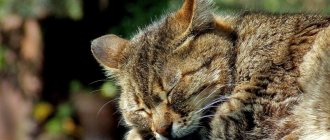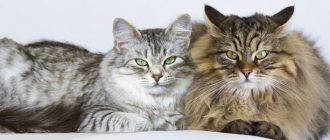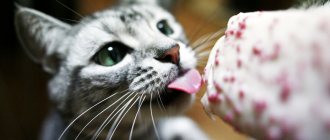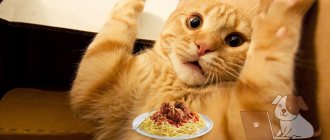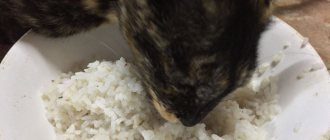This article describes what ailurophilia is.
There are many different attachments in the world, which we call diseases, and vice versa, there are illnesses that can simply be called a sick hobby or addiction to something. This can be said about ailurophilia. Many people still do not understand whether this pathology should be called a psychological deviation, or whether it is still a manifestation of an excessively good attitude towards animals. So what is ailurophilia - a disease or love for cats. Let's figure it out together in this article.
Why do people love cats
A soft, cozy creature that loves to curl up at the owner’s feet into a fluffy ball and emit a pleasant purr - a symbol of a warm, bright home, happiness, comfort and love. This is the main reason why people prefer to have mustachioed striped animals as pets. For many people, these animals are associated with peace and tranquility.
The way a person treats cats can tell a lot about his character. Psychologists have developed their own characteristics of people who cannot imagine their life without a furry purr:
- Women : They are often compared to cats, and for good reason. The fair sex, who loves cats, is just as graceful, well-groomed and full of mysterious secrets. She craves love, knows how and wants to give it back. But at the same time, she is independent and not always logical in her actions. Often women who do not have a family or children get cats to give them affection. At the same time, they know that in return they will receive boundless and selfless love. But there are pitfalls here. A cat, accustomed to receiving attention and affection, may have an extremely negative attitude towards the appearance of a man in the house.
- Children : a child who loves cats, gentle and affectionate. Most children are afraid of dogs, but are drawn to cats, and this happens at the level of instinct. This is explained by the fact that in a calm and cozy cat, babies see a reflection of their mother. In families with small children, psychologists recommend having cats. Such proximity makes kids flexible and calm, loving and responsible in the future. Contact with a cat helps alleviate stress for a baby who is weaning from breastfeeding.
- Men : if a representative of the stronger sex has a cat as a pet or has a weakness for cats, this indicates his soft and flexible character, his willingness to always seek compromises to make everyone comfortable and comfortable. Such men are less susceptible to stress, aggressive behavior and outbursts of irritability.
What kind of people are they who don’t like cats? There are also those who cannot stand purring. But in most cases, the reason lies in the subconscious, the presence of psychological problems:
- A woman who does not like cats does not perceive, does not realize, and even denies her feminine nature.
- Most men are misogynists. Men with non-traditional sexual orientation are not particularly fond of cats, but this is not a mandatory rule, but rather an observation.
Cats don't have to be liked by everyone; some people simply prefer other animals, finding them cuter. But if a person hates cats, there is an explanation for this in the form of a number of psychological reasons.
Ailurophilia: causes of the disease
According to Western scientists, 46% of people with ailurophilia are single women, most often elderly. But among pathological cat lovers there are also quite young people of both sexes. Introverts and those who have experienced severe psychological trauma, such as losing their loved ones, are often susceptible to mental disorder.
Treatment of this disease is the task of specialists in the field of clinical psychology and psychiatry, because ailurophilia often coexists with dementia, schizophrenia or bestiality.
According to the observations of doctors, people who share similar personality traits are at risk: low or unstable self-esteem, emotional instability, lack of meaningful and reliable social contacts. In this case, cats not only fill the spiritual emptiness, but also give the sick person the opportunity to feel his own superiority - after all, there are living beings nearby who depend on him.
At the same time, a number of studies show that loving cats in itself does not increase the risk of mental disorders. In 2011, French scientists conducted a broad analysis of data from 37 countries and found that cat owners are no more likely to have mental disorders than those who have never owned cats. In 2012, observations of 600 thousand older people were carried out in the UK - the conclusion was the same.
Is toxoplasmosis to blame?
Recently, scientific publications showing the relationship between infection with toxoplasmosis and the development of mental illness have become more frequent. For example, parasitologists from Stanford University in the USA found that Toxoplasma gondi, entering the cerebellar amygdala, which is responsible for positive and negative emotions, causes a living creature to change a set of conditioned reactions.
Parasites can have a similar effect on a person, causing him certain deviations in behavior, including those when he turns his home into a kind of animal den, forgetting about his own comfort and hygiene, not to mention the people around him.
Indeed, the causative agent of toxoplasmosis is one of the few parasites that can overcome the blood-brain barrier and, once in the brain, disrupt its functioning, but it is still not the only one. Disturbances of higher nervous activity can also be caused by echinococcosis and toxocariasis, and it is much easier to become infected with them.
Thus, cats, or rather, contact with their feces, can cause the disease with toxoplasmosis, but this way is far from the only one, and even more so, not all people develop a painful love for cats or other mental disorders against the background of toxoplasmosis.
Psychology of cats - features
Everyone knows that cats are independent.
To understand how much, you can pay attention to the scientific fact: dogs “get infected” by yawning from people, but cats never repeat it after a person.
Considering the fact that repeating a yawn after someone is related to such a feeling as empathy, this perfectly explains the psychology and attitude of cats towards humans.
If you want to get a kitten, it is recommended to take into account the peculiarities of the psychology of these animals:
- Cats openly express their attitude towards humans, and not only in general, but also at a certain moment . You can often see this behavior from a pet - the cat lies on its back, clasps the owner’s leg with its front paws, and begins to make intense movements with its hind paws, similar to beating. At the moment, the pet is actually hitting the person, and not playing with him. The animal beats with its front paws - it shows its reluctance to communicate, trying to show the person that he needs to leave.
- Games . Cats are designed in such a way that they do not perceive uniform movements for a long time, simply cutting them off. This is why many owners are perplexed why their pets do not want to play with a new toy, quickly losing interest in it. If you make impetuous movements with the toy, impulsively waving it and periodically pausing, Murka will be delighted with such a game. And evenly waving, like a fan, will lead to the fact that after 30 seconds the cat will stop perceiving the object and will look through it.
- You can train a cat . The only paradox is that this takes too much time, during which a person, without realizing it, will be raised by his pet.
- For a cat, the owner is not the one who feeds him and cleans the litter box . The owner is the one who took the kitten in his arms after the mother, who raises it, even if this is punishment for pranks. And the one who feeds is just a “feeder”.
Having trouble raising a cat? It's not about her mental abilities, but about her approach to this issue. To raise a cat, you should act consistently and not rush. If an animal decides that the manipulations that a person performs with it are just nagging and a manifestation of the owner’s bad mood, it will continue to do its dirty tricks. Or it may react differently: take offense at the owner and deliberately commit unpleasant pranks.
Features of behavior:
- There is an opinion that certain breeds have a tendency towards aggression. It is not true. The pet’s malicious behavior and tendency to do “bad things” are only the result of a lack of proper attention and education, which spoils the animal’s character. With equal probability, notes of aggression in behavior can be observed in an active Siamese cat that is not properly handled, and in a British cat, endowed with a phlegmatic disposition by nature, but by chance finds himself in a family with noisy and overly active household members.
- Cats don't like dogs - not because they see them as competitors or are afraid of being their prey. This hostility is explained by the peculiarities of cats’ perception. They do not like sudden movements (unless they are made by potential prey). If a dog runs around a cat, it will not understand what they want from it - to eat or play. The result of such encounters is the same - in case of close contact, the dog will receive claws on the nose as a precaution.
- Rumbling in cats is a sign not only of complete relaxation and pleasure, but also a way to attract attention. And if the animal does not immediately get what it wants, the rumbling intensifies. If we draw an analogy, it is comparable to the human “ahem.”
- Cats are extremely rarely able to remember a specific person. At the same time, their associative connections are configured in an amazing way. For example, a cat will consider all men to be veterinarians if one was a doctor with whom he had previously been in contact. Cats also have associations based on smell. If a scented guest cuddled and caressed a cat, she will henceforth associate this smell with tenderness and attention to herself.
- When purchasing a kitten, the owner may rack his brain for a long time over a suitable nickname, while assuming that cats are unlikely to remember and understand their names. In fact, cats remember nicknames very well, however... they don’t always respond to them. When the owner calls the cat by name, she wonders whether she should go, whether she will get something pleasant in return, or whether it is better to continue to lie lazily and mind her own business. In most cases, the second option wins.
Good moms
Many people are accustomed to thinking that any cat has an incredibly developed maternal instinct, which it shows not only in relation to its kittens, but also to human cubs. It is not always so. There are cats that don’t particularly care for their offspring, caring for and raising kittens only because no one else will do it for her.
There is also the opposite situation - a cat who is a supermom. She is really ready to babysit not only her own kittens, even if they are already adults, but also strangers, not allowing their own mother near them. Cats are amazing and completely unpredictable animals that do not always fit into certain behavioral patterns.
Ailurophilia
Ailurophilia (gatophilia, galeophilia) is a mental disorder of a person suffering from pathological, uncontrollable attachment and immense love for cats. Often, painful attachment is observed in elderly and lonely women who have no one else to care for. With this disorder, people can simultaneously keep up to several dozen cats, without being able to provide them with acceptable living conditions. The cat family helps to cope well with loneliness, filling the house with its presence and replacing departed loved ones. In most cases, ailurophilia is observed in individuals who find it difficult to get along with other people. The mass keeping of cats creates a lot of inconvenience for other residents of the house due to the violation of silence and sanitary rules. Ailurophilia can manifest itself not only in older people, but also in young people, both women and men. Lonely or isolated people who have lost their loved ones, or people who are sexually attracted to cats are at risk.
Man - friend or feeding slave
Even the most affectionate, sweet and gentle pet can at any moment wag its tail and leave a person, stopping communication with him for a while.
Unlike devoted dogs, who are ready to follow their owner everywhere with inexhaustible love, cats prefer to maintain independence and a bit of disdain in their relationships with humans.
Features of the relationship between cats and people:
- According to the research of anthrozoologist John Bradshaw, the cat perceives a person as a “brother-in-law,” only a very large and safe one.
- The owner’s “lisping” with the cat, “intimate” conversations with him or addressing him as a small child, and not as an animal - all this is a desire to endow a cute pet with qualities characteristic of a person.
- Although cats have been kept as pets by people for a long time, they are not as close to their owners as dogs. This is due to the peculiarities of the period of their domestication. When taming dogs, a person communicated with him on equal terms, because the task was to make the dog understand them. With cats it's a different story. A person needed them to protect his house from mice. Cats lived next to people, but at the same time they existed as if in a parallel world.
- For the mustachioed and striped people, man is not the center of the world. No matter how gentle and affectionate a pet may be, you should not expect bright manifestations of feelings and the same reciprocal love from him. Cats live their own lives, occasionally allowing close contact with people, and only when they want it.
- When a cat brings a caught mouse into the house, many owners are touched, believing that the pet wants to share a meal with them. However, the purr is not capable of such “generous” actions. He simply brought his prey to a quiet place where no one would lay claim to it.
- The cat demonstrates its disposition towards the person and the desire to receive affection and attention from him accordingly - he begins to rub against the owner’s legs and expose his head, tilting it to the side, so that he can be scratched behind the ear. The cat will behave the same way towards its fellow tribesmen.
When placing high hopes on your pet, expecting absolute obedience and good behavior from him, you should remember that a person is not the cat’s owner, but only his big “neighbor” who feeds and cares for him.
Sphinx
- Weight: 2.7-5.4 kg
- Life expectancy: 8-14 years
- Breed type: hairless
If you've ever had the opportunity to meet a Sphynx, then you know how sweet, charismatic and tenacious these cats are. They can cuddle with you for hours. You may not know, but Sphynx cats have a slightly higher core body temperature than other cat breeds. This is because their body gets used to the absence of warming fur.
Sphynx cats love people so much that they sometimes act as if their goal is to please you. At the same time, they are very energetic and fun to play with.
The Sphinx is known for its friendliness and curiosity. He is happiest when he is next to his beloved owner. Another fun fact about these hairless cats? This is actually a natural breed native to Canada.
Interesting facts about the psychology and behavior of cats
Cats are unique creatures, but sometimes people find their behavior strange and funny:
- Each cat has his own preferences regarding the appearance of the female. One male may be completely indifferent when he sees a tortoiseshell or red cat near him, and show intense interest when he meets a black cat.
- Many cats at shows get very nervous because of the large number of people and unfamiliar surroundings. These nerves manifest themselves in constant tail twitching. This is easy to deal with - the owner pinches the tip of the tail with his fingers, returning it to a static position, and the cat immediately calms down. The effect is triggered - there is no opportunity to show your nervousness - which means there is no nervousness itself.
- Cats have a sense of humor, but a “peculiar” one. Their favorite pastime is to quietly get close to another cat and scare him with his sudden appearance.
Maine Coon
The gentle giant Maine Coon is the largest of all domestic cat breeds and has a heart as big as he is! These cats, with their long, silky coats, rank high on the list of friendliest breeds. The Maine Coon loves everyone around him - from children to other pets. Loves long, quiet hugs and restless games. He will often rub his head against you and follow the shadows of those people he loves, making it clear how dear and important they are to him! Maine Coons love to sit on your lap, sleep on your bed, be present at your table and live in your heart!
Cat tongue or how to understand a pet
Considering the peculiar and extremely capricious nature of cats, it is quite possible to make life with them comfortable for both parties if you learn to understand pets, recognizing their mood and desire by certain postures and sounds made:
- Hisses - warns that he doesn’t like how they treat him (read more about why cats hiss).
- Snorting - wants to divert attention from himself, in the same way he can express confusion and surprise.
- Grumbles - shows an extreme degree of dissatisfaction.
- Rumbling in a low range - ready for his own defense, which means he is extremely wary of the current situation.
- “Meow,” said briefly, is a greeting.
- Smacks his lips or clicks his teeth - he shows the instinct of a hunter, but at the same time he shows irritation that he was unable to catch the prey.
- He purrs - he is absolutely satisfied with his position.
- “Meow”, played with a slight hoarseness, shows gratitude and good attitude.
Poses and their explanation:
- Sits, covering his paws with his tail - complete moral and physical relaxation, absolute calm. In this position, it can watch with interest its owner or what is happening outside the window.
- Shifts from paw to paw, rubs against a person’s legs - this is how a pet greets its household members.
- Rubbing its head against a person’s legs or his face shows openness and complete disposition towards the owner.
- The back arches - it’s scary.
- The fur stands on end, the paws straighten sharply, the body is raised high - it feels threatened.
- Lying with his stomach up is a posture of thoughtfulness, dozing.
- The tail is raised up - the animal is calm and friendly.
- A ruffled and drooping tail is an expression of complete confusion.
- The tail hanging down and tapping it on the floor is a sign of fear.
- It intensively wags its tail in different directions, the tip touches its paws - it is in an extreme state of irritability and can behave aggressively at any moment.
What the eyes will tell you. You can also understand a cat’s mood by the expression in its eyes:
- Eyelids are half-closed - relaxation, a feeling of peace and absolute calm.
- Eyes wide open - a manifestation of incredible interest.
- The pupils are greatly dilated - fear and fright.
- Looking away to the side - she is ready to obey and do what her owner wants from her.
- Looks into a person's eyes, ears directed forward - interest, desire to communicate or receive a treat.
Knowing how a cat shows emotions, you can predict its desires and needs, assess your pet’s readiness to make contact or its desire to be alone.
